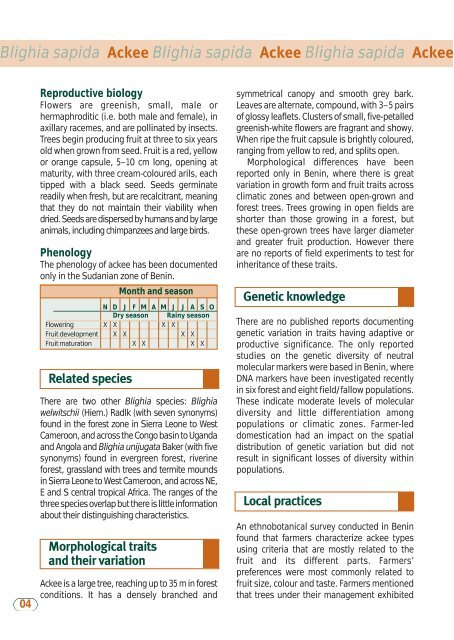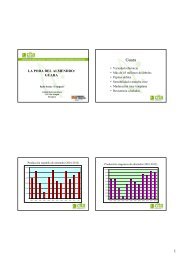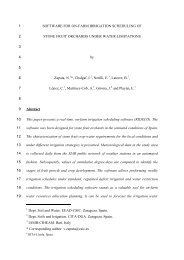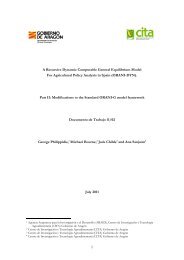Blighia sapida Ackee Blighia sapida Ackee Blighia sapida Ackee
Blighia sapida Ackee Blighia sapida Ackee Blighia sapida Ackee
Blighia sapida Ackee Blighia sapida Ackee Blighia sapida Ackee
Create successful ePaper yourself
Turn your PDF publications into a flip-book with our unique Google optimized e-Paper software.
<strong>Blighia</strong> <strong>sapida</strong> <strong>Ackee</strong> <strong>Blighia</strong> <strong>sapida</strong> <strong>Ackee</strong> <strong>Blighia</strong> <strong>sapida</strong> <strong>Ackee</strong><br />
04<br />
Reproductive biology<br />
Flowers are greenish, small, male or<br />
hermaphroditic (i.e. both male and female), in<br />
axillary racemes, and are pollinated by insects.<br />
Trees begin producing fruit at three to six years<br />
old when grown from seed. Fruit is a red, yellow<br />
or orange capsule, 5–10 cm long, opening at<br />
maturity, with three cream-coloured arils, each<br />
tipped with a black seed. Seeds germinate<br />
readily when fresh, but are recalcitrant, meaning<br />
that they do not maintain their viability when<br />
dried. Seeds are dispersed by humans and by large<br />
animals, including chimpanzees and large birds.<br />
Phenology<br />
The phenology of ackee has been documented<br />
only in the Sudanian zone of Benin.<br />
Month and season<br />
N D J F M A M J J A S O<br />
Dry season Rainy season<br />
Flowering X X X X<br />
Fruit development X X X X<br />
Fruit maturation X X X X<br />
Related species<br />
There are two other <strong>Blighia</strong> species: <strong>Blighia</strong><br />
welwitschii (Hiem.) Radlk (with seven synonyms)<br />
found in the forest zone in Sierra Leone to West<br />
Cameroon, and across the Congo basin to Uganda<br />
and Angola and <strong>Blighia</strong> unijugata Baker (with five<br />
synonyms) found in evergreen forest, riverine<br />
forest, grassland with trees and termite mounds<br />
in Sierra Leone to West Cameroon, and across NE,<br />
E and S central tropical Africa. The ranges of the<br />
three species overlap butthere is little information<br />
about their distinguishing characteristics.<br />
Morphological traits<br />
and their variation<br />
<strong>Ackee</strong> is a large tree, reaching up to 35 m in forest<br />
conditions. It has a densely branched and<br />
symmetrical canopy and smooth grey bark.<br />
Leavesare alternate, compound, with 3–5 pairs<br />
of glossy leaflets. Clusters of small, five-petalled<br />
greenish-white flowers are fragrant and showy.<br />
When ripe the fruit capsule is brightly coloured,<br />
ranging from yellow to red, and splits open.<br />
Morphological differences have been<br />
reported only in Benin, where there is great<br />
variation in growth form and fruit traits across<br />
climatic zones and between open-grown and<br />
forest trees. Trees growing in open fields are<br />
shorter than those growing in a forest, but<br />
these open-grown trees have larger diameter<br />
and greater fruit production. However there<br />
are no reports of field experiments to test for<br />
inheritance of these traits.<br />
Genetic knowledge<br />
There are no published reports documenting<br />
genetic variation in traits having adaptive or<br />
productive significance. The only reported<br />
studies on the genetic diversity of neutral<br />
molecular markers were based in Benin, where<br />
DNA markers have been investigated recently<br />
in six forest and eight field/fallow populations.<br />
These indicate moderate levels of molecular<br />
diversity and little differentiation among<br />
populations or climatic zones. Farmer-led<br />
domestication had an impact on the spatial<br />
distribution of genetic variation but did not<br />
result in significant losses of diversity within<br />
populations.<br />
Local practices<br />
An ethnobotanical survey conducted in Benin<br />
found that farmers characterize ackee types<br />
using criteria that are mostly related to the<br />
fruit and its different parts. Farmers’<br />
preferences were most commonly related to<br />
fruit size, colour and taste. Farmers mentioned<br />
that trees under their management exhibited
















